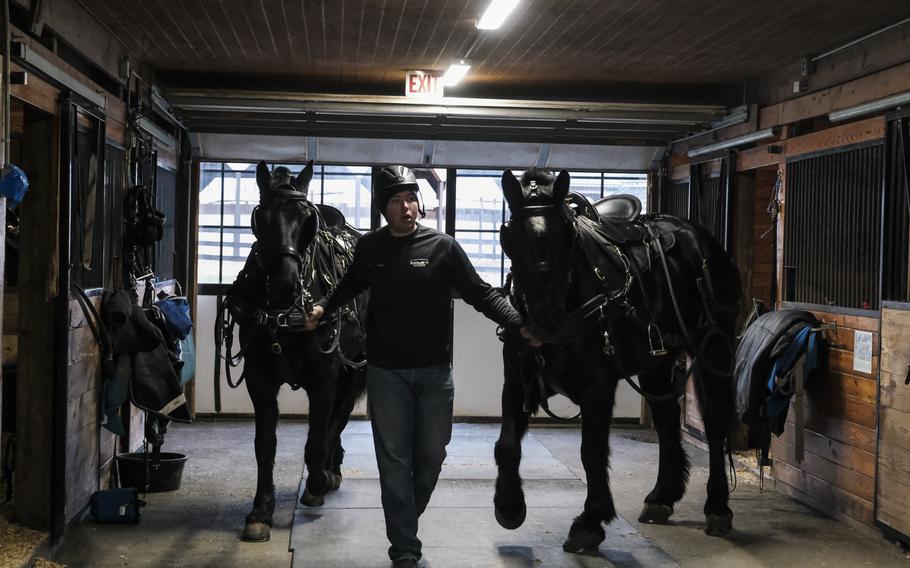
Army SPC Dylan Branden, a soldier assigned to the 3rd Infantry Regiment caisson detachment, participates in a training exercise last year at the NOVA Equestrian Center in Virginia. (Michael A. McCoy/The Washington Post)
The Army said Tuesday that it was partially resuming its horse-drawn caisson program for funerals in Arlington National Cemetery, three years after an investigation found that neglectful treatment of horses had contributed to a spate of equine deaths.
Maj. Gen. Trevor J. Bredenkamp said the resumption comes after a complete overhaul of the program, in which certain deceased service members are conveyed to their graves in horse-drawn artillery wagons, or caissons. Funding was boosted, Bredenkamp said. Soldier horsemanship training was revised. Custom-made saddles were acquired for the horses. And the weight of the old caissons was reduced.
“We had to basically reinvent the way we were doing these things,” Bredenkamp, commanding general of Joint Task-Force National Capital Region and the U.S. Army Military District of Washington, said in a phone news briefing.
The caisson service, long a fixture at the historic cemetery just outside Washington, was suspended in 2023, stemming from the earlier deaths of four Army horses and reports of poor conditions in the Army stables and inexperienced staff.
The solemn tradition of bearing the dead on a caisson is tied to the battlefield role of the wagons as they delivered supplies to the front lines and returned with dead and wounded soldiers, according to the Military District of Washington website.
Horse-drawn caissons are often used during state funerals, such as the rites for President Jimmy Carter in January. His casket was carried up Capitol Hill by the first of the new caisson units the Army is training, Bredenkamp said.
Perhaps the most memorable use of the horse-drawn caisson was during the 1963 funeral of President John F. Kennedy, which was watched by millions of people on television.
The cemetery caisson service will resume on a limited basis starting the week of June 2, but horse teams and personnel will start getting used to moving through the cemetery later this month, the Army said in a statement.
The service will increase as the Army acquires more horses and trains more soldiers for the program.
Problems with the caisson unit first came into public view in 2022, when an Army investigation found the horses’ living conditions in stables neglectful, contributing to four equine deaths.
A later report put the horse death toll at 11 over an eight-year period. Other reports found horses bore scars from ill-fitted tack, too tight for their bodies.
The investigation determined that the overworked horses lived in cramped stalls and paddocks, and were given contaminated feed. A necropsy of one horse found 44 pounds of gravel in its gut, a result of unsanitary living conditions.
After a year of physical rehabilitation efforts for the roughly five dozen horses the investigation centered on, all were quietly retired, too old and too broken to continue working.
Not all funerals in Arlington get a caisson. In general, those eligible include service members killed in action, recipients of the Medal of Honor or the Prisoner of War Medal, senior noncommissioned officers, senior warrant officers and senior commissioned officers, the Army said.
Bredenkamp said funding for the program went from about $1.2 million a year in 2022 to about $10 million now. He said the program now has 46 horses, many of which have been acquired since last summer.
He said even though the caissons are much lighter now, the Army is looking for a more modern caisson for the future.